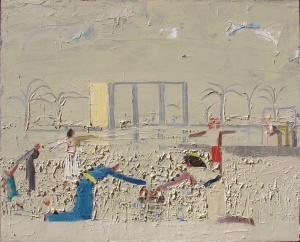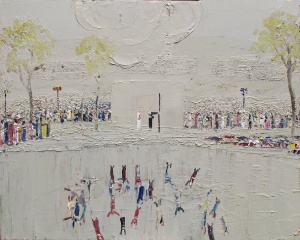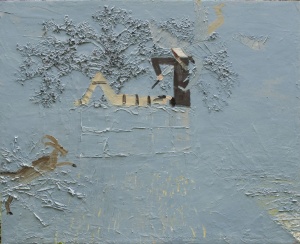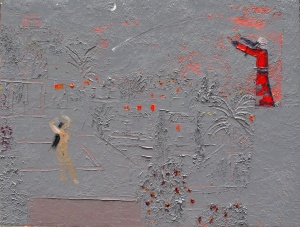Biblical Space: Recent Works by John Bradford
John Bradford is back with a dozen masterful paintings that deliver a powerful reassessment of Biblical narratives, served up in a revolutionary new painterly format. Last seen in these pages in November 2010, Bradford’s new work, Biblical Space at the Bowery Gallery until February 22, is a transformation of how he treats the surface of the painting, a game-changing reassessment he has been working towards most of his long artistic career.
Bradford has opted to fully exploit the diverse possibilities of the physical surface by concentrating on three-dimensional application of paint (impasto) and other material. While this tactic is certainly not inherently unusual in contemporary painting, here his use of types and variations of texture in the exclusive service of narrative meaning is significant both in its sophistication and control. With admirable restraint he patiently builds up the surface, scrapes it down, etches into it and selectively adds gritty encrustations to develop fully unexpected narrative insights to a litany of familiar biblical subjects.

These subjects can be evenly divided into those that concern the national Jewish narrative and those that concern the more intimate, familial stories. Fundamentally, our narrative as a nation begins with the Finding of Moses. Bradford asserts the unrelenting flatness of the Egyptian universe with its landscape, punctuated by palm trees and a minimalist regal structure at the horizon, in tension with a reed-clogged foreground, as the epitome of Egyptian materiality. This is the nexus where Moses is simultaneously placed by his mother on the left and rescued by Batya, Pharaoh’s daughter, on the right, literally extracted from an impasto morass of Jewish slavery.
Next the tragedy of the Golden Calf is depicted; the sour yellow idol framed by two impastoed trees. While far in the background we can see a tiny Moses coming down the mountain with the two tablets, the shocking revelation is in the foreground figures bowing down to none other than the figure of Aaron, the hapless facilitator of the golden deity. Bradford’s insight that Aaron could become an object of worship is especially troubling and yet terribly believable.

The early tragic missteps of the Jewish people climaxes with Korah’s Rebellion, also set in a gray neutral landscape in which every aspect of surface can carry enormous narrative weight. We see the multitudes of the Jewish people arrayed on either side of a stark, blank shape; the very absence of materiality, the holy Tabernacle. Moses and Aaron stand before it, at the edge of the precipice that slices off the entire bottom half of the painting. In a vertiginous fall Korah’s entire crew plummet headfirst, swallowed whole and alive. The thick gray impasto hovering in the sky is immediately recognizable as the Cloud of Glory, the Divine Presence fulfilling the terrible and devastating prophecy by Moses. (Numbers 16:28) The restrained use of color and monochromatic physical space allows the dramatic changes in surface texture (smooth, rough, stippled or scraped), to explicate the narrative and create a sense of immediacy and horror.
In a total change of tone and sensibility, Adam and Eve in Eden becomes curiously playful, depicting Eve in profile, reaching for the forbidden fruit as a blue speckled snake approaches her, stretching across the left side of the painting. Immediately on the right the consequences of disobedience oppress Adam, seen laboring in the muck and observed by a most colorful turkey!

By abandoning local color (i.e. naturalistic coloring), Bradford frees color to operate in a subtle and psychological realm, such as the eerie and unnerving baby blue of The Akeida. This subject has been depicted by him dozens of times over the years, but here the limited (and disarming) color and violent impasto combine to create a child-sacrifice unlike any other. The lush impastoed bush that encompasses father and son points to a fertile future about to be destroyed. Suddenly the angel appears etched into the same color as the sky, grasping the knife and halting the sacrifice from behind. Pointedly, the angel’s arm does double duty (as observed by critics Joan Boykoff Baron and Reuben M. Baron) as the intervening agent and, seen in another light, a reversed knife that threatens to stab Abraham himself; visually commenting that if Abraham were to slaughter Isaac he would be destroying everything he believed in; an act of suicide. The artist has brought us to the precipice of God’s greatest test of Abraham.

In an exhibition of fascinating biblical insights, David and Bathsheba stands alone. The gray monochrome painted over a barely visible red underpainting casts an ominous pall over the early evening scene. Bathsheba is featured in the left foreground, her flesh tones almost indistinguishable from the surrounding patio. In a shocking manner, she is not the focus of David’s gaze. He is positioned on the right and above, clothed in violent deep red, reaching out his arms towards the crescent moon that hangs picturesquely in the sky above. A shooting star arches just below it, completing the image of David effectively worshiping the moon and stars. The audacious intent of the painting is that in David’s lust for Bathsheba he was guilty of idolatry, i.e. star worship. Notwithstanding the Talmudic dictum that David did not sin in the Bathsheba episode; both the Gemara itself in many places and an honest reading of the text points to a deeply troubling event having occurred. Bradford’s painting unflinchingly confronts the issue in no uncertain terms.
John Bradford’s new paintings assault the sanctity of modernist picture plane conventions offering gravely antinomian understandings of the greatest narratives the Torah has to offer.
Biblical Space: Recent Works by John Bradford
The Bowery Gallery; 530 West 25th Street, 4th floor, 646 230 6655
Tuesday-Saturday 11am-6pm bowerygallery.org
Until February 22, 2014